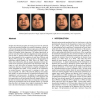Free Online Productivity Tools
i2Speak
i2Symbol
i2OCR
iTex2Img
iWeb2Print
iWeb2Shot
i2Type
iPdf2Split
iPdf2Merge
i2Bopomofo
i2Arabic
i2Style
i2Image
i2PDF
iLatex2Rtf
Sci2ools
APGV
2008
ACM
2008
ACM
Probing dynamic human facial action recognition from the other side of the mean
Insights from human perception of moving faces have the potential to provide interesting insights for technical animation systems as well as in the neural encoding of facial expressions in the brain. We present a psychophysical experiment that explores high-level aftereffects for dynamic facial expressions. We address specifically in how far such after-effects represent adaptation in neural representation for static vs. dynamic features of faces. High-level after-effects have been reported for the recognition of static faces [Webster and Maclin 1999; Leopold et al. 2001], and also for the perception of point-light walkers [Jordan et al. 2006; Troje et al. 2006]. Aftereffects were reflected by shifts in category boundaries between different facial expressions and between male and female walks. We report on a new after-effect in humans observing dynamic facial expressions that have been generated by a highly controllable dynamic morphable face model. As key element of our experiment, we...
| Added | 12 Oct 2010 |
| Updated | 12 Oct 2010 |
| Type | Conference |
| Year | 2008 |
| Where | APGV |
| Authors | Cristóbal Curio, Martin A. Giese, Martin Breidt, Mario Kleiner, Heinrich H. Bülthoff |
Comments (0)

